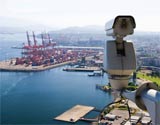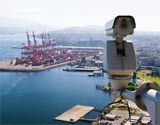
Perimeter Prowess
Using video analytics to prevent acts of terrorism
- By John Whiteman
- Mar 02, 2009
 Acts of terrorism can be carried out in many forms and at various locations around the world. Those who pose the most risk are individuals or groups that breach secured areas of critical infrastructure facilities, such as seaports and airports, government buildings or power and chemical plants.
Acts of terrorism can be carried out in many forms and at various locations around the world. Those who pose the most risk are individuals or groups that breach secured areas of critical infrastructure facilities, such as seaports and airports, government buildings or power and chemical plants.
With today’s video analytics technology, however, security personnel are one step closer to keying in on persons or objects that pose a threat to highrisk facilities.
A Common Weakness
By detecting suspicious behaviors such as loitering, idling vehicles, fence jumping, trespassing and leaving unattended objects, the ability to prevent a terrorist act is heightened. By employing surveillance cameras equipped with video analytics, these actions can be detected before one gains entry into a critical facility.
Border crossings, airports, seaports, power, nuclear and chemical plants, dams, and military and government facilities all share a common weakness—the vulnerability of their perimeter.
Terrorists have identified these sites as potential targets, either for direct attacks on personnel or, in the case of nuclear power and chemical plants and dams, as saboteurs who seek access to harmful chemicals and nuclear matter or to taint the water supply or disrupt power.
According to the Homeland Security Research Corp., U.S. border and perimeter protection is among the fastest developing segments of the Homeland Security market. This sector alone is forecast to spend $13.9 billion by 2011.
Proactive Protection
While metal detectors, whole body imaging and other technologies are successfully deployed inside a facility, a key to preventing an act of terrorism is to stop the perpetrators before they set foot on the property.
In a typical multi-camera, multiscreen security system, it is often difficult or impossible for security personnel to determine unapparent suspicious behaviors. For example, is that person loitering or just taking a break? How long has that package been there? Often, it’s difficult to tell.
Intelligent video pinpoints potential situations based on 3-D vision and recognizes patterns of behavior. Unlike its traditional video counterpart, analytics sends out alerts when a threat is detected, providing early warning along with video verification of events while significantly minimizing false alarms.
Through the use of pre-programmed scenarios, loitering can be detected and an alarm can be sounded when a person or group remains in a controlled area for a prolonged period. With a simple mouse click, video can be replayed showing how and when the person or group appeared in the area. The system also can alert officers on patrol to approach the area and confront the individuals.
This can be especially important at remote facilities with little or no onsite presence, as is the case with several power plants’ transmission stations and substations. By detecting loiterers or persons crossing into controlled areas, personnel can be alerted and dispatched to check out the incident. Meanwhile, the cameras record the activity for future identification or forensic purposes.
Additional Capabilities
Employing analytics can reduce the number of guards required to patrol a facility and monitor surveillance footage in a security room. Video analytics also has the ability to detect and alert when a vehicle has stopped or is idling in a controlled area. Different scenarios can be programmed into the system to identify various suspicious behaviors, including a car blocking a driveway, vehicles waiting at a gate or a car entering a loading dock area.
In the case of unattended items, video analytics can detect when an item was positioned, presenting responders with more information and ensuring greater safety at the scene. The system not only alerts to bags planted by an individual but also to items that were dropped into or thrown onto the scene from off camera. This is critical for detecting potential baggage bombs that may be planted on site or tossed from a moving vehicle.
Conversely, analytics also can detect when an object has been removed. This can be significant in facilities with chemicals or weaponry. An alarm is sounded when an object is removed or has been out of its place for longer than a predetermined time period.
One of the most highly used applications of video analytics in surveillance situations is intrusion detection. Keeping persons out of critical areas is the first step in thwarting a terrorist act. Typically, there are two modes of detection: generating an alarm when a person or vehicle moves within a prohibited area and alarming when a tripwire, or demarcation line, is crossed.
Analytics can be programmed to detect only specific types of actions. For example, it can be set up to alarm only when vehicles travel in the wrong direction or when individuals stray outside public areas in a protected building such as an airport, a courthouse or a museum.
Recently, the Vatican in Rome installed ioimage’s video analytics as an effective deterrent against intruders. With millions of people visiting the Vatican’s library and museum each year, the system needed to be adjustable to the frequent changes in the public access schedules, while also being reliable and able to deal with varying weather conditions.
The units are monitored and managed from a central control room by the Corpo della Gendarmeria, the Vatican’s security force.
ioimage appliances also have been installed at the Korea Electric Power Cooperation, a government-invested electric utility at Korea’s Daesan Seaport on the coast of the Yellow Sea. In these instances, the facilities upgraded their existing CCTV security systems with video analytics to automate surveillance and provide immediate notification and instant visual verification.
Unique Obstacles
Seaports provide a unique challenge because physical fences or border crossings can’t be erected. In this case, the tripwire function is deployed, with an invisible line of demarcation determined by presets that trigger an alarm when crossed.
To reduce the incidence of false alarms, intrusion detection can be linked to specific size and movement parameters that most closely match those of individuals or vehicles, while taking into account movement of trees and animals.
Analytics also can provide notification if a camera is being tampered with, including attempts to sever the cables, cover the lens or redirect the view.
Today’s analytics are user friendly with simple installation and out-of-the-box operation. Initially analytics were softwarebased or hybrid-architecture-based, but some of today’s leading systems are hardware- oriented solutions. Rather than investing in stand-alone PCs to run video analytics software, security managers can plug analytics edge devices into any network and transform an existing camera into a proactive, intelligent detector or can purchase an IP camera that has built-in analytics.
Either way, the system is scalable and provides the ability to integrate with future infrastructure, thus maximizing existing investments. The growth of video surveillance and the continuing convergence with IP are helping to fuel the acceptance of analytics, especially in critical, terrorist-threat situations.
Although the threat from terrorism is constant, the reality of these economic times calls for a cost-effective solution that can operate with the existing security infrastructure. Retrofitting can provide end users with the best value and highest level of security as well as offer a quick and easy system to install and cost-effective to maintain.
This article originally appeared in the issue of .